Flags on the beaches: what do they mean? Travel tip: Color flags on the beach
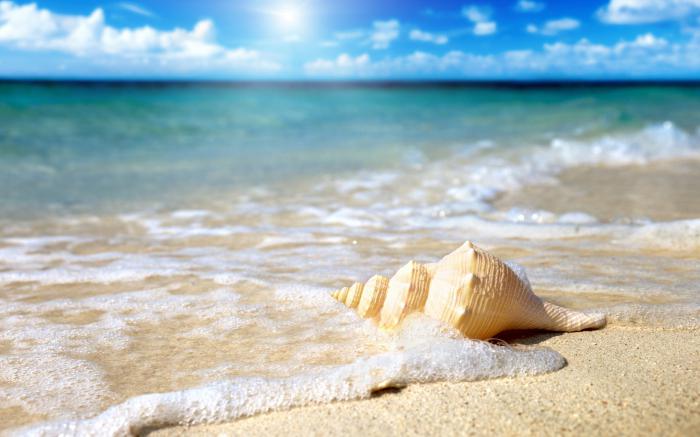
How many met the blue flag on the beach? What does it mean? Apparently, this is not so well known. Therefore, it is worth figuring out what the special flag means and whether it makes sense to look in advance for such marked beaches.
Beach holiday
Many people can not imagine your vacation without the caressing sun and sea. Therefore, every year the warm southern resorts take a huge number of tourists who aspire to the beaches. But their requests vary: someone likes a calm sea, and others like small waves and wind. For some, the pebble beach or sandy turns out to be critical, and there are people and generally with special requests. But be that as it may, everyone understands that it is necessary to rest on the other side, which is perfectly safe, where there is all the necessary equipment.
On many beaches of the world acts special system colored flags, which show that, for example, there are creatures dangerous to people in the sea, or the waves are too big, and therefore swimming is prohibited. But the same colors are not always used, so you can easily get confused in the notation. But there is an international sign - the Blue Flag on the beach. What does it mean?
Blue flags
The problem of assessing the quality of beaches has become relevant for quite some time, and already in 1985 a special system began its work. Initially, it operated only within Europe, but in 2001 the organization that certifies recreation sites by the sea became global. Today it has about 50 member countries in Eurasia, Africa, Oceania, North and South America. Initially, the blue flag on the beach meant high quality of sea water (by several parameters), today they are marked only by those places that meet almost 30 different criteria. Obviously, this sign is very prestigious, and such beaches attract more tourists. That is why every year requirements are becoming tougher, but more and more recreation areas receive these awards, and more and more countries are joining a kind of club. Certification of beaches in the eastern hemisphere is held in May-June, and - in early November.
Award Criteria
Before each season, the beaches of the countries participating in the project are certified. It takes into account many parameters, divided into the following categories.
1. Water quality:
- Compliance with the requirements of the EU Directive.
- Lack of dumping of industrial sewage.
- Presence of local or regional action plans in case of pollution from accidents.
- Prevent accumulation of algae in resting places.
- Meeting urban wastewater treatment requirements.
2. Environmental awareness:
- The presence of at least 5 educational programs.
- Timely information on the occurrence or expected pollution of the beach.
- Providing visitors with information about applicable laws and codes, as well as rules of conduct.
- Informing about dangerous areas near the coast, including the habitats of local flora and fauna, representatives of which can harm humans.
- The presence of a special educational center.
- Timely updating and updating of all information provided.

3. Environmental management:
- Having enough garbage cans that are regularly serviced and emptied.
- Carrying out a regular, and if necessary, daily cleaning of the beach.
- The existence of a land use and coastal development plan separately or on a regional scale.
- Full transport without special permission, unauthorized camping, dumping of waste and car or motorcycle racing on the beach.
- Having secure access.
- Actively promote the use of environmentally friendly modes of transport for visiting the coastal zone.

4. Security:
- Availability of all first aid equipment on the beach.
- Strict implementation of state laws regarding the stay in the recreation area of various animals.
- The presence of lifeguards on the beach and the necessary equipment and / or another way to ensure safety and prevent accidents.
- Access to drinking water.
- The presence of a working phone, if the rescuers do not work on the beach.
- All buildings and structures should be kept in order and clean.
Not all of the above criteria are mandatory, some of which are recommendations. And yet, to get the highest score - the blue flag - every year the authorities are trying to make the beaches better and better. And many succeed: in 2015, there were 4,159 places on the world map that were awarded this quality mark. The beaches marked with the Blue Flag have received a huge number of tourists over the summer, while not forgetting to maintain the necessary level of safety and cleanliness. The prestige of this award is so high that many people even plan their vacations, focusing on the most highly regarded recreation areas. So where are most of them located?

Spain
Each year, the Blue Flag is assigned to a huge number of beaches. In 2015, Spain was the first in terms of the number of such places - on its map 577 certified sections of sea coasts were counted. Most beaches, ecological purity and safety of which is confirmed, are located in Galicia. In second place was Valencia, and in third - Catalonia. Let's see if Spain will manage to keep the lead in 2016 and, possibly, improve the result? In the meantime, an inexperienced tourist is much more difficult to get to the beach, not marked by a flag, and soon it will probably be completely impossible.

Turkey
In the spring of 2015, it turned out that another popular southern country won silver in the competition for the number of certified beaches. It was Turkey with a score of 436. Most of the noted beaches are located in the regions traditionally popular with Russians - Bodrum, Kemer, Antalya, Marmaris. And there is hope that next year even more places will receive a distinction - the Blue Flag.
Greece
In third place from last year's second, with a score of 395 recreation areas, Hellas moved, losing as many as 13 marked coasts. Obviously, the crisis affecting Greece caused, among other things, the fact that the government focused on more topical issues. Most of the local beaches, over which the Blue Flag flutters, are concentrated in the traditional resort places - on Crete and the peninsula of Halkidiki.

France
Country that spawned the movement Blue flags, in 2015, ranked fourth in their number. France lagged behind Greece very little - on its territory there are 379 beaches that meet all the criteria of environmental cleanliness and safety. The blue flag holiday spots are fairly evenly located on the coast. A sufficient number of them is located near the English Channel, as well as the Mediterranean Sea and the Atlantic Ocean.
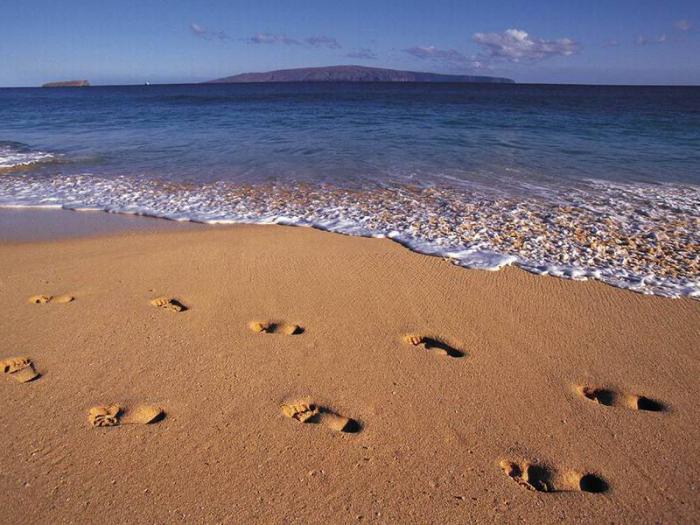
Cyprus
Another country that enjoys constant love among residents of northern latitudes, in 2015 received 57 awards, as in the past year, and almost all of them are concentrated in the southern part of the island. It may seem that it is a little compared to hundreds in previous countries. However, let's not forget about the small size of the island. It is worth mentioning, by the way, that Cyprus is a kind of record holder: firstly, there are holiday resorts in per capita, and secondly, the largest number per unit of coastline length. Mostly with the Blue Flag are located in the areas of Limassol, Larnaca, Ayia Napa and Famagusta.
Russia
Despite the fact that the Russian Federation is not so many warm places with beaches, for several years she participates in the program of the Blue Flags. Unfortunately, for all this time only a couple of yacht clubs were awarded the prestigious award, but not a single beach has been certified for compliance with European standards. But let's not be discouraged: perhaps in the coming years the situation will change for the better.
In the rainy season, water safety becomes particularly relevant. Rescuers, constantly on duty near the water, warning signs and flags, fenced dangerous areas for swimming - but even this is not enough for particularly gambling and careless travelers to not try to subdue the waves at this time.
Therefore, many will be useful and just interested to know what the typical flags set on the beaches of Thailand, including Phuket, mean. Perhaps knowledge will help save someone's life. In addition, not all flags talk about danger, some just inform about the characteristics of the selected beach.
So, what do the flags on the beaches mean?
All flags comply with international standards and have colors characteristic of traffic lights and warning signs. In Phuket, warning signs accompanying the flags are signed in seven languages: Thai, English, Russian, French, German, Korean, and Chinese.
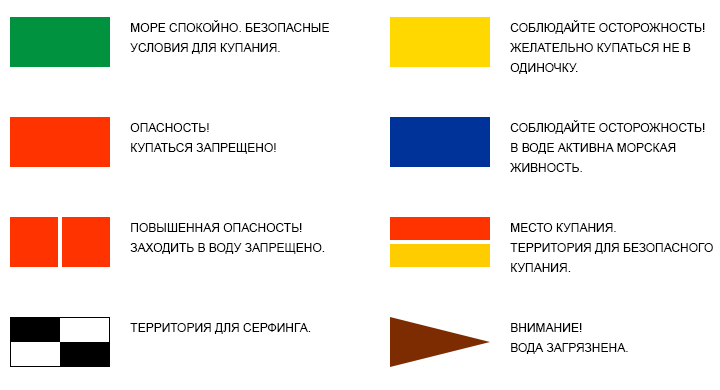
Green flag : You can safely swim, the sea is calm.
Red flag : Due to hazardous conditions (in Phuket, above all, these are strong waves), swimming is prohibited.
Two red flags near : Strong undercurrent, rips. It is strictly forbidden to even go into the water.
Black and White Chess Cage : Places for surfers. On these beaches there are always separate signs that share places for surfing and swimming places for ordinary citizens.
Yellow flag : allows you to swim, but it is recommended to do it by company.
Purple flag : dangerous marine animals live in these waters (jellyfish, stingrays, sea urchins). If the purple flag is hung in a pair with yellow, this indicates the extremely active activity of these marine inhabitants.
Red and yellow flag : You can swim in this place, but carefully. The territory is always under the supervision of rescuers, but this does not save you from responsibility for your life. As an option, red and yellow flags can be fortified together.
Brown flag : Pollution of the environment or water. Option - orange flag.
Pay special attention to the double red flags, because it is in such places that dangerous dangerous undercurrents await you - rips, which can destroy even a professional swimmer. Entry into the water is strictly prohibited. Do not be deceived by the sunny and clear weather: rips appear precisely in such conditions. If you still got into the rip, do not try to fight, but surrender to the will of the current.
Follow the warning signs and your vacation will be remembered only from the positive side.
Maybe a crisis, maybe it has ceased to be popular among young people, and maybe all real lifeguards left for Malibu, but the fact is there are no lifeguards, these beautiful demigods with bronze tan, snow-white smile, red swimming trunks and bathing suits and a funny rescue buoy do not exist leash Instead, the sad inscriptions No lifeguard on duty. How to navigate the rest? How to avoid the dangers in such a difficult situation? For this there is a system of flags.
It is noteworthy that these flags are seen only on the coast of Florida, which has the longest coastline.
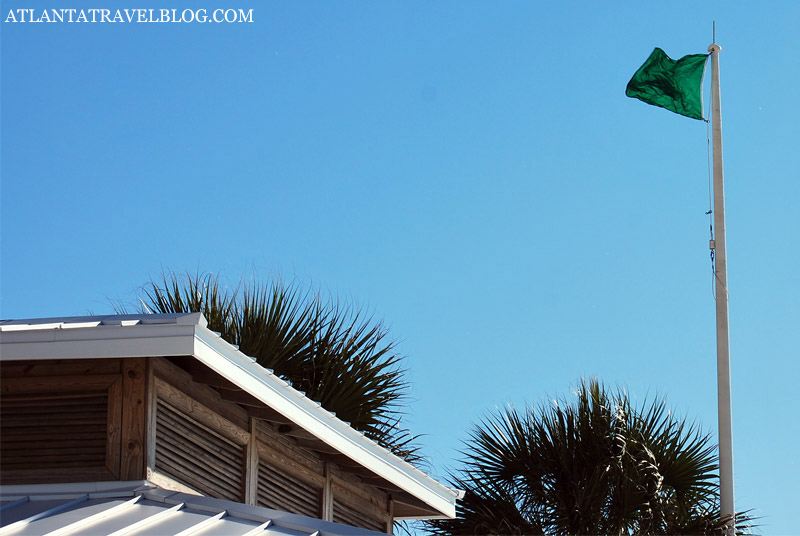
2. Green flag - everything is good, you can swim without fear.
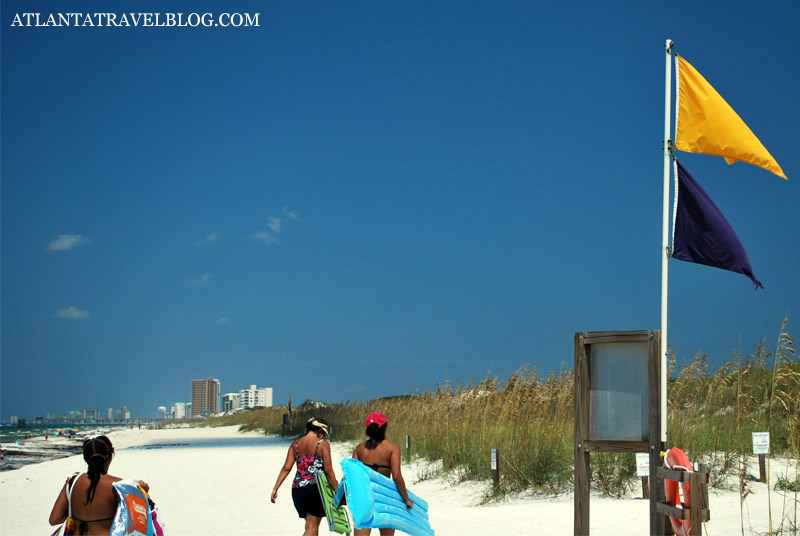
3. Yellow flag - medium danger, moderate surf and current. But below is a purple flag, meaning that the marine life is active. As a rule, it hurts the stinging jellyfish. And the photo shows that people are leaving the beach - with a purple flag you don’t buy too much ...
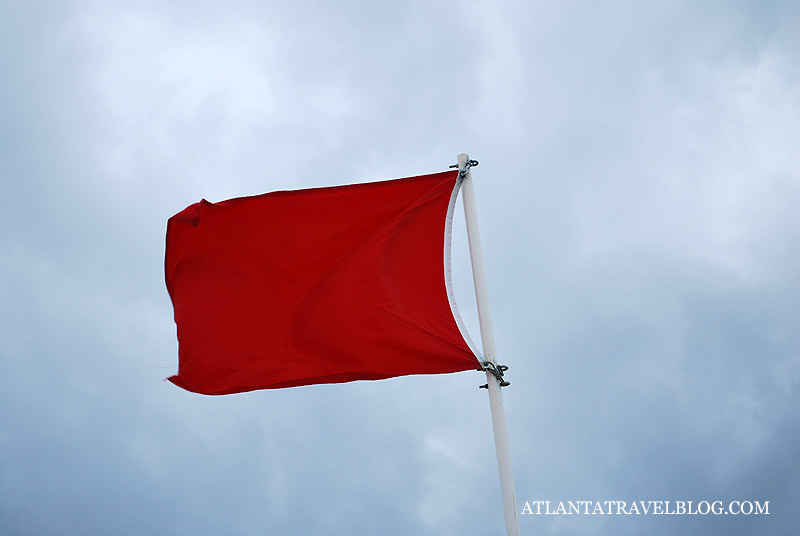
4. Red flag - high danger, strong waves and current. Two red flags - the water is closed. Fortunately, there was no such frame in the photo archive of the blog Atlanta Travel.

5. This is the complete list of warning flags on the beach.
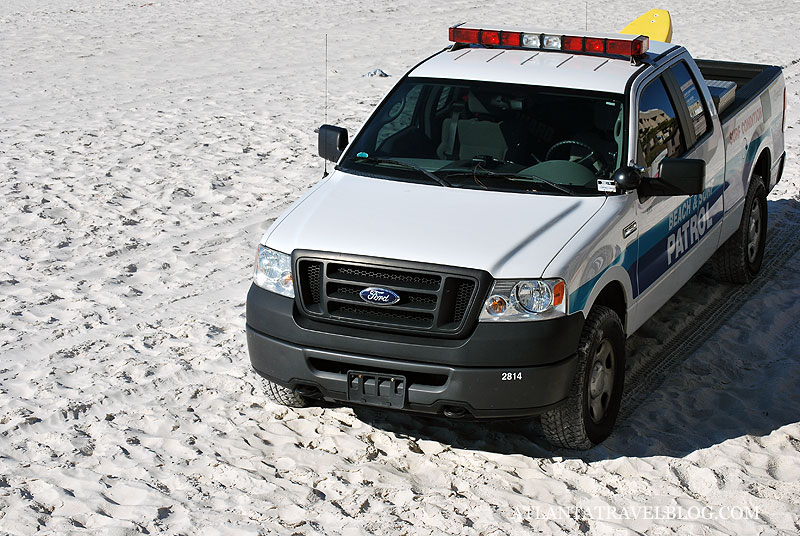
6. How are the coast flags updated? This is followed by a special coastal patrol, which for such rides around the coast and, if necessary, changes the flags.
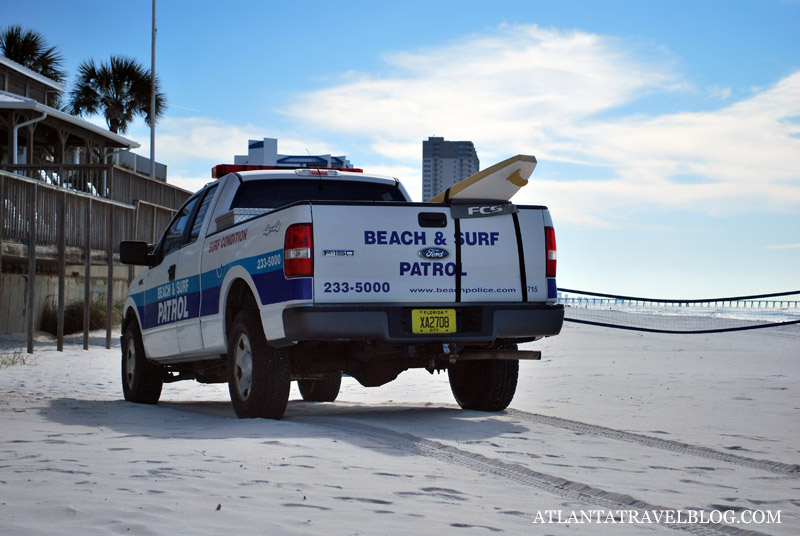
7

8. In addition to warning flags on the coast there are lifebuoys.

9. A special poster of rescue on the waters tells about how to behave if you were suddenly drawn from the coast by the current.
Related records
- Riddles for girls on 8
- When on the ship two flags
- Order on the creation of the duty dispatch service
- Historical flags of the states of 1700
- The role-playing game as the main type of games for preschoolers place in the structure of children's games
- Logic Tricks for Adults
- Medical Institute with budget places

 Live journal
Live journal Facebook
Facebook Twitter
Twitter